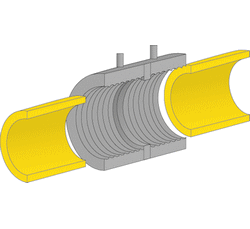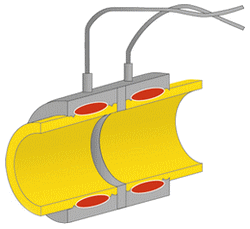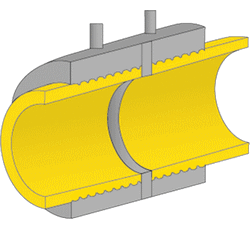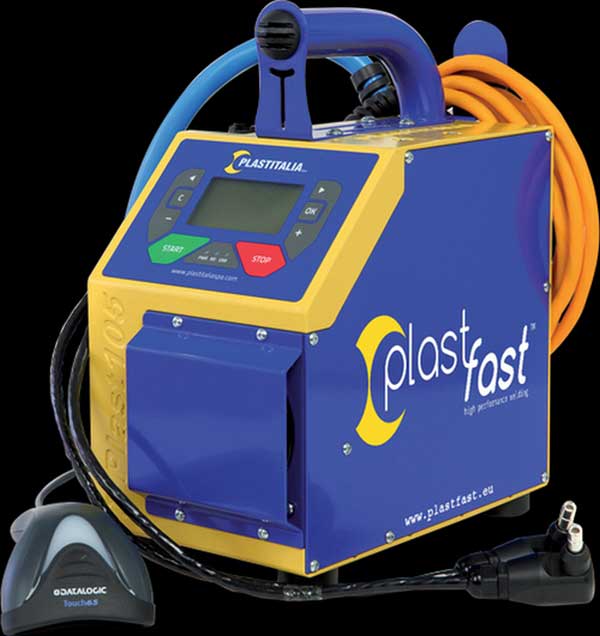Electrofusion Welding |
Electrofusion welding is a technique for joining thermoplastic pipes using a molded sleeve with an electrical resistance heating coil and an electrofusion machine.
An electric current is passed through the coil, generating heat that melts the thermoplastic material at the joints. Once the current has sufficiently melted, it is interrupted, allowing the plastic to cool and solidify into a seamless, durable joint.
Electrofusion welding is a crucial technique in polyethylene production due to its effectiveness, precision, consistency, and reliability. It is an essential welding method for industries that rely on strong polyethylene pipeline systems, such as water supply, agriculture, mining, and more. The resulting fittings are highly reliable, but it is important to emphasize that the preparation and joining process must be meticulously followed to prevent connection errors. Training is essential, as is quality assurance to ensure every step is followed.
The Electrofusion Process
In electrofusion welding, an electrofusion fitting is placed over the joint between two pipe ends, where it has been peeled and cleaned.
The electrofusion welding device applies electricity to the heating coil integrated into the electrofusion fitting. This heats the plastic in the welding zone so intensely that it melts.
Unlike pipes, fittings such as elbows or tees do not require a separate connection sleeve (electrofusion fitting). Fittings have the same properties as the connection sleeve (coupler) for pipe connections.

Electrofusion fitting
connect two pipe ends

Electrofusion fitting
heat up the plastic

Electrofusion fitting
gas-tight connection
Electrofusion Process cont'd.
To ensure a successful and reliable result, the electrofusion elding method consists of several steps.
Step 1: Material Preparation
Before beginning the electrofusion process, thorough material preparation is essential.
- Thoroughly clean the ends of the pipes and fittings to remove dirt, grease, and other contaminants.
- Straighten the ends of the pipes.
- Ensure that the surfaces are smooth and free of any imperfections that could adversely affect the welding process.
- Clean the pipe surfaces with isopropyl alcohol and a lint-free cloth.
Step 2: Connecting the Fitting
The second step involves connecting the fitting to the pipe ends.
- Place the electrofusion fitting between the pipes to be connected. The fitting contains embedded resistance wires or coils.
- Carefully align the pipes and insert them into the coupling so that they fit together perfectly.
Step 3: Clamping
Secure the pipe end and fitting securely in the electrofusion machine by following these steps.
- Place the clamping tool around the pipes and fittings. Tighten the clamps to secure the pipes and fittings. This prevents movement during welding.
Step 4: Alignment Check
Checking for proper alignment is essential before beginning welding.
- Check that the pipes and fittings are properly aligned. Misalignment can lead to weak, defective, and leaky connections.
- Make sure the pipes are centered in the fitting and that any alignment indicators align with those on the pipes, if necessary.
Step 5: Heating and Melting
How to perform the heating and melting process correctly.
- Start the electrofusion machine, which sends a controlled electric current through the wires in the fitting.
- The current generates heat, melting the thermoplastic material of the pipes and fitting.
Step 6: Cooling and Finishing
Proper cooling and finishing techniques are essential for improving the strength and integrity of
the electrofusion weld.
- After the material has sufficiently melted, the electrofusion welder will turn off the power at the appropriate time. Allow the joint to cool and solidify completely without moving anything. The cooling time varies depending on the pipe size, material age, and ambient temperature.
- Inspect the joint for irregularities, voids, or signs of melting or insufficient fusion, and check that the pressure indicators on the fitting have both risen.
- Protect the joint from possible damage or disruption. This involves handling the pipes carefully and avoiding external stresses.
At a minimum, all of the above steps must be completed for the electrofusion process; however, a manufacturer may require additional steps during preparation.
References..
Images: www.pfs-gmbh.com
Booklet: Europa - Fachbuch Reihe
Text general:
www.fhs.com.au
www.plastitaliaspa.com
Electrofusion Welding of Pipe
Electrofusion Welding of Fittings
Related Post(s)

In laser beam transmission welding, a part transparent to the laser and a laser-absorbing part are always joined together. Before welding, the joining partners are positioned and then pressed together...


